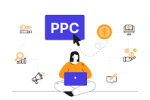Remarketing is a powerful PPC strategy that allows businesses to re-engage potential customers who have previously visited their website. By using targeted ads, you can remind users about your products or services and increase conversion rates.
1. What is Remarketing?
Remarketing is a digital advertising technique that targets users who have interacted with your website or ads but haven’t converted yet. This helps businesses stay top-of-mind and boost return visits.
2. How Does Remarketing Work?
- A user visits your website but doesn’t make a purchase.
- A tracking pixel (cookie) is placed on their browser.
- The user browses other sites, and they see your ad.
- They click the ad and return to your website, increasing the chance of conversion.
3. Benefits of Remarketing
✅ Keeps your brand visible to potential customers. ✅ Increases conversion rates with targeted ads. ✅ Allows personalized ad messaging based on past interactions. ✅ Cost-effective way to recover lost leads.
4. Types of Remarketing
🔹 Standard Remarketing
Shows display ads to users who have visited your website before.
🔹 Dynamic Remarketing
Displays personalized ads featuring products/services that users viewed.
🔹 Video Remarketing
Targets users who have interacted with your YouTube videos.
🔹 Email List Remarketing
Targets users who have subscribed to your email list but haven’t converted.
🔹 Learn more: PPC Management
5. Best Practices for Effective Remarketing
🎯 Segment Your Audience
- Target cart abandoners with discount offers.
- Show ads to users who visited specific product pages.
- Create separate ads for returning vs. new visitors.
📢 Use Engaging Ad Creatives
- Eye-catching visuals that remind users of what they saw.
- Compelling CTAs like “Limited Time Offer!” or “Come Back & Save!”.
- Keep messaging consistent across platforms.
🔹 Learn more: Content Writing
⏳ Control Frequency Capping
Showing ads too often can annoy users. Set a limit on how many times an ad appears per user.
🎯 Optimize for Conversions
- Direct remarketing traffic to high-converting landing pages.
- Use A/B testing to refine ad performance.
🔹 Learn more: Google Ads Strategy
6. Setting Up a Remarketing Campaign in Google Ads
- Create an audience list in Google Ads Audience Manager.
- Set up a remarketing tag on your website.
- Segment your audience based on past behavior.
- Design compelling remarketing ads with a strong CTA.
- Launch the campaign and monitor performance.
Final Thoughts
Remarketing is a game-changer for PPC success, helping businesses recover lost leads and increase conversions. Implement it today to boost your ROI! 🚀
📞 Need help with PPC remarketing? Contact us today!
📧 Email: Syed_66@hotmail.com 📞 Call: 0161 399 3517 🌐 Visit: Social Media Max

